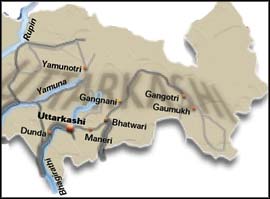What caused the landslides in Uttaranchal?
 On the night of September 24, residents of Uttarkashi in the Garhwal Himalayas were jolted by rumblings of rocks and boulders hurtling down the Varunavat parvat (hillock). Landslides have ravaged this ancient pilgrimage town ever since. Many buildings including high-rise hotels and houses have come under a steady stream of mud, boulders and broken rock pieces that slide down from Varunavat parvat , a mighty hillock overlooking the town of 20,000 people. Fortunately, no human casualty has been reported, though the material loss has been significant. The Uttarkashi district administration reacted by clamping a red alert in the area and evacuating about 3,000 people living along a one-kilometre stretch on the Uttarkashi-Gangotri road, that separates the hillock from the township.
On the night of September 24, residents of Uttarkashi in the Garhwal Himalayas were jolted by rumblings of rocks and boulders hurtling down the Varunavat parvat (hillock). Landslides have ravaged this ancient pilgrimage town ever since. Many buildings including high-rise hotels and houses have come under a steady stream of mud, boulders and broken rock pieces that slide down from Varunavat parvat , a mighty hillock overlooking the town of 20,000 people. Fortunately, no human casualty has been reported, though the material loss has been significant. The Uttarkashi district administration reacted by clamping a red alert in the area and evacuating about 3,000 people living along a one-kilometre stretch on the Uttarkashi-Gangotri road, that separates the hillock from the township.
Why did it happen? Geologists are clueless about the exactcause of the event. So are residents of the town. According to Suman Rawat, a social worker and physics professor in the local government college, heavy rains in the intervening night of September 23-24, "Seems to have set off the landslide.'
The site of the calamity has since been surveyed by a multi-institutional scientific team drawn up from the Dehra Dun-based Wadia Institute of Himalayan Geology, Geological Survey of India ( gsi) and the Roorkee-based Central Building Research Institute ( cbri) . Their preliminary report, submitted to both the district administration and the Uttaranchal government, notes that a lot of debris is still accumulated on the top of the hill. A rough estimate by the scientists indicates that debris amounting to about 40-50,000 cubic metres is still to come down. And until the debris throw is over, a detailed study is difficult, the report said. According to eyewitnesses, the land-movement, that began on September 24, is still continuing, making it a peculiar geological event.
Shantanu Sarkar, the cbri scientist who led the team, says the dislocated debris that is yet to come down is stuck on a gentle slope on the hillside. Whenever the sun is up, the moisture that holds the fractured rocks together evaporates, releasing rock pieces. And this, according to Sarkar, explains the steady stream of rocks and mud sliding down into Uttarkashi town during daytime. Fallen trees occasionally hasten the fall.
Many other geologists also categorise the current landslides in Uttarkashi as a debris flow. Such a landslide is characterised by an extremely rapid flow of a mixture of rock fragments, boulders, cobbles and gravel. This mass is set in a matrix of sand, silt and a little clay, with variable quantity of water. The debris is released as a result of weathering of rocks and the processes of deforestation. It then moves down the slope
